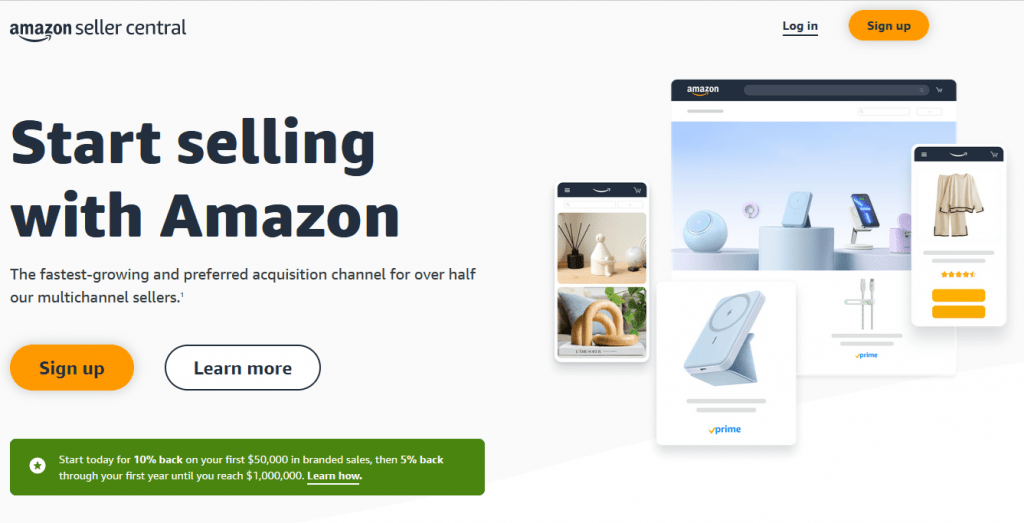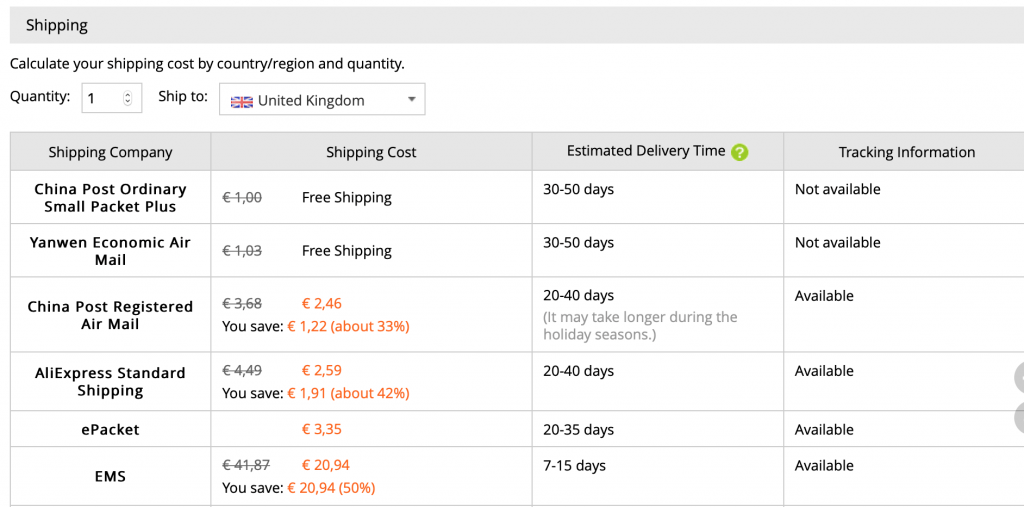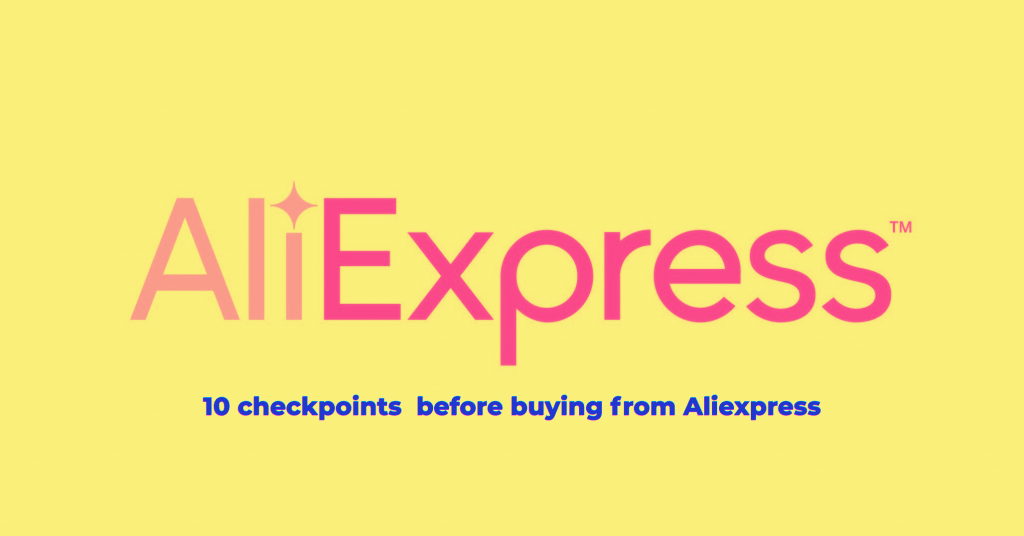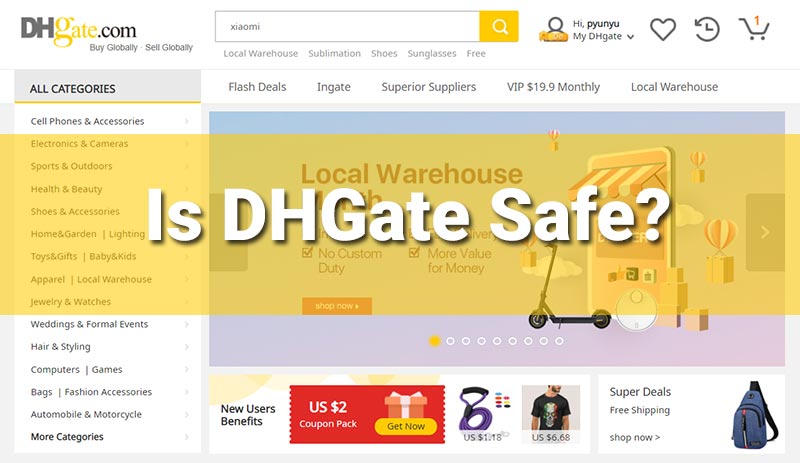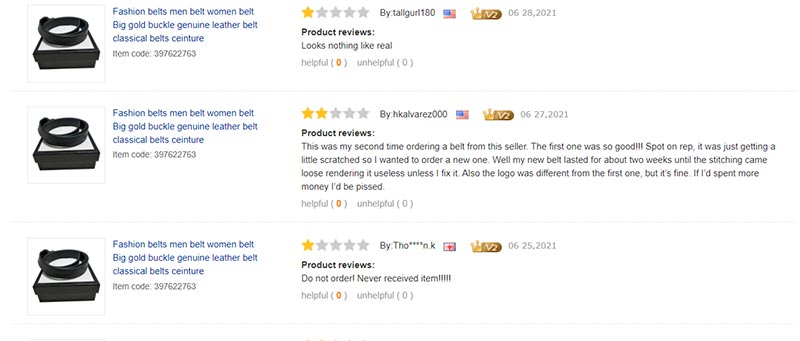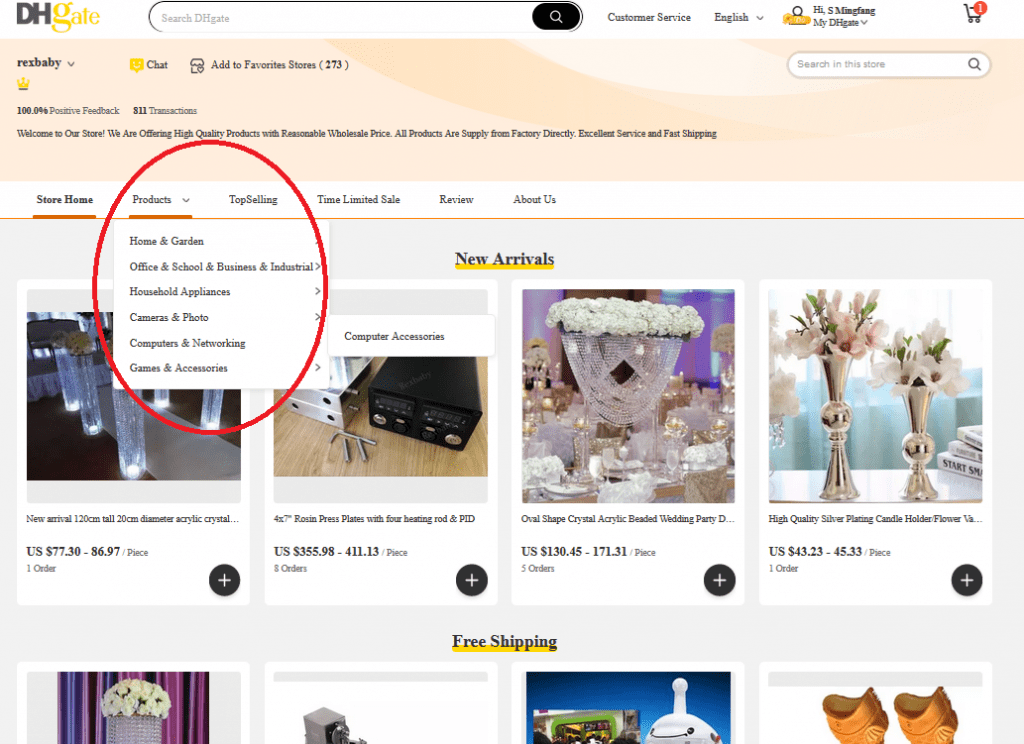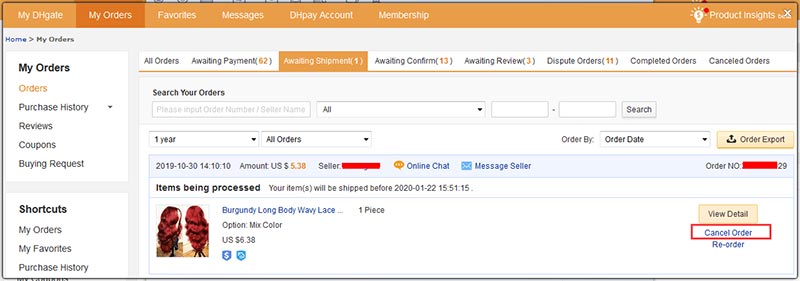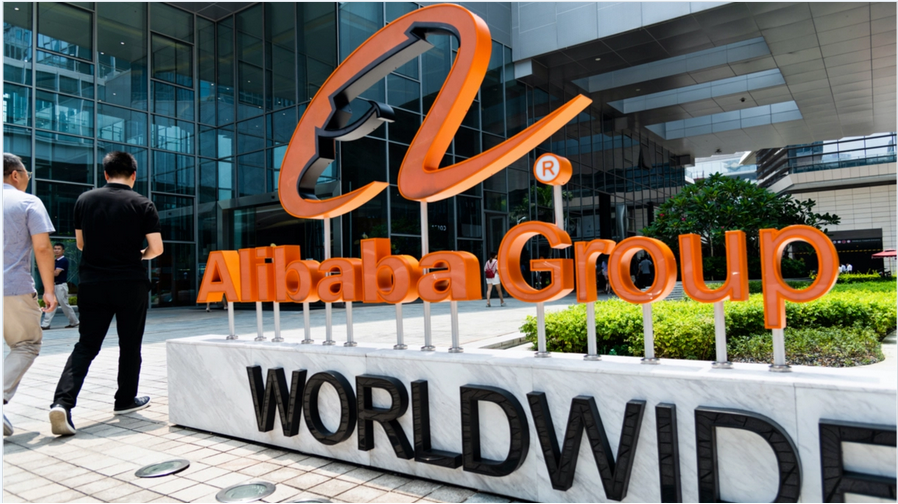Amazon FBA vs Dropshipping: Which Model Works Best in 2024
Amazon FBA and dropshipping stand out as top picks in the eCommerce realm. While they may seem alike, their approaches to inventory management set them apart.
Both methods lend a hand to eCommerce entrepreneurs by streamlining order handling and logistics. This optimization is key for managing multiple orders efficiently, making the choice of eCommerce model critical for new online ventures.
Let’s dive into the comparison of Amazon FBA vs dropshipping, exploring differences in definitions, shipping costs, and weighing their respective pros and cons. By the end, we’ll offer insights to aid in the decision-making process between dropshipping vs Amazon FBA for online product sales.
What Is Amazon FBA
Amazon FBA simplifies warehousing and shipping for businesses.
With Amazon FBA, eCommerce store owners can ship products to Amazon’s fulfillment center instead of managing their own warehouse. From packing to delivery, Amazon Warehouse handles the entire shipment process for each customer order.
Amazon, being a major player in online retail, offers global fulfillment networks. In 2022, a whopping 68% of Amazon users took advantage of this service, drawn by its seamless order fulfillment process and top-notch product inventory.
With Amazon FBA, sellers gain access to the Inventory Performance Dashboard, enabling them to keep a close eye on factors influencing their Inventory Performance Index (IPI) score. Additionally, the seller toolkit comes in handy for managing oversupply, tracking inventory age, updating product listings, and ensuring stocks are maintained.
Moreover, Amazon FBA provides shipping promotions, allowing FBA sellers to cut down on shipment expenses and boost their profit margins.

Pros of Amazon FBA
Starting with Amazon FBA is a breeze(Dropshipping vs Wholesale). Just follow a few simple steps. First, set up your Amazon FBA account and organize your products into listings on the FBA inventory. Then, prepare and ship your products to Amazon’s fulfillment centers and let them handle the rest.
You don’t have to deal with customer support(Dropshipping vs Ecommerce). Amazon’s customer service takes care of buyer inquiries, saving you time. Customers can reach out to Amazon anytime, and there are no extra FBA fees for this service.
Amazon FBA gives you immediate access to a global audience(Dropshipping Suppliers for Amazon). It helps eCommerce owners expand their reach internationally. For instance, the FBA Pan-EU scheme ensures fast delivery across European countries. Plus, with FBA Export, you can tap into markets in over 100 countries.
Returns and refunds are made easy with Amazon’s FBA program(Amazon FBA vs Dropshipping). It offers clear policies and support for customers looking to return purchased items. Through the online return center, customers can easily initiate returns, refunds, replacements, and reimbursement requests.
Amazon FBA takes care of storing, organizing, and managing your inventory in their fulfillment centers(Amazon FBA vs Dropshipping). This means you don’t have to worry about finding storage space, handling inventory counts, or dealing with stockouts.
Products fulfilled by Amazon are eligible for Prime shipping(Dropshipping Suppliers for Amazon), which is a huge advantage on the platform. Prime members are more likely to purchase products that offer fast and free shipping, and having Prime eligibility can significantly increase your product’s visibility and sales potential.
Winning the Buy Box is crucial for driving sales on Amazon(Amazon FBA vs Dropshipping). The Buy Box is the box on the product detail page where customers can add items to their cart. Products that win the Buy Box are featured more prominently and are more likely to be purchased.
Cons of Amazon FBA
High Competition (Amazon FBA vs Dropshipping): Given Amazon’s widespread popularity, competition can be fierce on the platform. You may encounter other sellers offering similar products at lower prices. To stand out, it’s essential to research and choose high-demand products with minimal competition. Additionally, competing against seasoned Amazon sellers may require extra effort and strategic planning to gain traction.
Profits Are Not Guaranteed (Dropshipping vs Ecommerce): While some products may sell quickly, turning a profit isn’t guaranteed in the competitive landscape of eCommerce. It’s crucial to implement effective marketing strategies and set competitive prices to ensure stable profits. This requires ongoing monitoring and adjustments to adapt to market trends and customer preferences.
Sales Are Restricted to a Single Platform (Dropshipping Suppliers for Amazon): Unlike dropshipping, where sellers can diversify sales channels, Amazon FBA limits your selling platform to Amazon’s marketplace. This means that any changes to Amazon’s policies or account termination can significantly impact your eCommerce business. To mitigate risk, consider diversifying your sales channels or expanding into other eCommerce platforms.
Customers Belong to Amazon (Private Label Supplements Dropship): With the Amazon FBA model, customer ownership belongs to Amazon’s platform. This limits your ability to directly engage with customers for customized marketing campaigns, such as affiliate marketing or email lists, to enhance customer loyalty. While Amazon provides access to customer data, utilizing it for personalized marketing efforts is restricted, posing a challenge for building long-term customer relationships.
What Is Dropshipping
Dropshipping is an eCommerce fulfillment model that involves third parties, such as retailers or manufacturers. It’s a highly popular business model, with the dropshipping market projected to reach $26 billion by 2027.
This model allows sellers to advertise and sell products online without the need to purchase stock upfront or manage inventory. When customers place orders, store owners forward the order details to third parties, who then handle product shipment directly to customers.
Dropshipping offers a streamlined process, as manufacturers handle all logistics from the get-go, allowing sellers to focus on brand building. However, there are important factors to consider, including market competition, niche selection, finding reliable dropshipping suppliers, and adhering to legal requirements when launching your business.
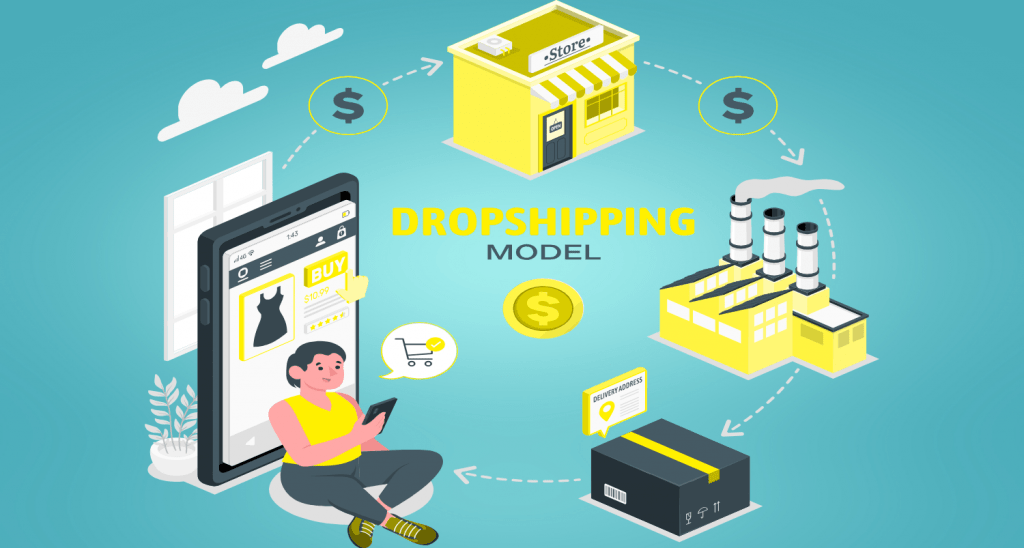
Pros of Dropshipping
Low Startup Cost (Dropshipping vs Wholesale): The dropshipping business model eliminates the need to manufacture or stock products, resulting in significantly lower startup costs for your eCommerce venture. This makes it an attractive option for entrepreneurs looking to minimize initial investment.
Less Responsibility (Dropshipping Suppliers for Amazon): With dropshipping, you’re only responsible for managing your eCommerce platform and forwarding order information to your dropshipping supplier. Your supplier handles the entire product shipping process, streamlining your business’s supply chain and reducing your workload.
Independent Location (Dropshipping vs Ecommerce): The dropshipping model offers the flexibility to operate your online store from anywhere, making it ideal for digital nomads and remote entrepreneurs. However, it’s crucial to partner with a legitimate and accessible dropshipping supplier to ensure smooth product shipments and maintain customer satisfaction.
No Upfront Investment (Private Label Supplements Dropship): Aside from minimal startup costs, dropshipping relieves you of operational tasks typically associated with traditional eCommerce models. Your dropshipping supplier manages inventory and fulfillment, eliminating the need to invest in warehousing or partner with large logistics companies. This makes dropshipping a viable option for business owners with limited resources or budget constraints.

Cons of Dropshipping
Slim Profit Margins (Dropshipping vs Wholesale): Starting a dropshipping business with a low budget may result in slim profit margins. Since you pay a predetermined amount to the supplier, upselling products might not yield significant returns. Customers may opt for alternatives offering better value, impacting your profitability.
Fierce Competition (Dropshipping Suppliers for Amazon): Due to its popularity, dropshipping faces fierce competition in the eCommerce landscape. Competitors may offer identical or similar products at lower prices, intensifying the competition and making it challenging to stand out in the market.
Dependency on the Manufacturer (Amazon FBA vs Dropshipping): In dropshipping, you don’t own the products you sell, relying on your supplier for information when handling customer inquiries. However, dropshipping suppliers for amazon may provide inaccurate shipping details, leading to customer dissatisfaction. Additionally, answering detailed product queries may require verification from your dropshipping suppliers for amazon, prolonging response times.
No Control over Item Quality (Private Label Supplements Dropship): A significant drawback of dropshipping is the lack of control over product quality. Since manufacturers handle packing and delivery, you can’t inspect outgoing products closely. It’s crucial to partner with trusted dropshipping suppliers to ensure product quality. Ordering items from them as a customer can help assess their reliability.
What Is The Difference Between Amazon FBA And Dropshipping?
These two fulfillment methods are pretty similar except for who owns the inventory. With both, your way of fulfilling orders to customers is completely hands-free and handled by another company.
The Owns of Inventory. A big difference between Amazon FBA and dropshipping is that with FBA, you already own the inventory and are using Amazon’s fulfillment network to handle your orders. If you are selling private label products for instance, you will place a large bulk order upfront with a dropshipping suppliers for amazon and send that inventory to an Amazon FBA fulfillment center.
The Time of The Supplier Ship the Order. With dropshipping, you don’t pay for any inventory until you receive an order from a customer. You will list a product for sale and, once you receive an order, you simply place an order with your dropshipping supplier, who will ship the order to your customer.
The Person Who Handles Customer Service. Another difference is that Amazon will handle customer service and returns for you when using FBA.
The Location of The Returns Go. With dropshipping, you are still using the FBM fulfillment method on Amazon, so you as the seller are responsible for returns and customer service. You cannot have your returns sent back to the supplier or manufacturer.
How Much Control You Have?

Algorithms And Reviews Control In Amazon FBA
Paid advertising on Amazon can drive traffic to your product page, but without reviews, you’re unlikely to make sales. Consumers rely on reviews to make purchasing decisions and trust products with positive feedback.
Getting reviews requires investment of time and money. Often, sellers resort to giving away products to incentivize reviews, adding to the cost. Additionally, obtaining reviews may involve “grey hat” strategies, like using software or private networks, which can violate Amazon’s terms of service and pose risks to your business.
This highlights a significant difference between Amazon FBA and dropshipping. With Amazon, you’re at the mercy of their control. Even if you’re following the rules, your page could be suspended or banned, resulting in financial loss and potential damage to your business reputation.
Our own experience with Amazon Kindle publishing reflects this uncertainty. Despite not violating any rules, our account was suspended arbitrarily. While we’ve since regained access and continue to generate income, we’re cautious about relying solely on Amazon for sales due to their unpredictable actions.
In comparison to other online businesses, Amazon FBA’s level of control is a crucial factor to consider.
You Are in Control In Dropshipping
Operating a dropshipping site offers unparalleled control. Even if Google suspends your account, you can easily create a new email or start a new store. There’s no inventory tying you down, and your funds remain accessible.
While Shopify may hold a portion of your payments, especially with a new Stripe account, it’s typically minimal. Ensuring proper documentation from dropshipping suppliers minimizes this risk. Alternatively, you can explore other payment processors for added flexibility.
In terms of risk, dropshipping is a superior option for starting an ecommerce venture. If you lack alternative income sources in your online portfolio, Amazon FBA may not be the ideal starting point.
Time Needed to Profit
Making money is the goal of any business, isn’t it? Let’s delve into comparing how quickly you can turn your first profitable dollar with each method.
It’s essential to distinguish between making your first sale and achieving profitability. We’re focusing on the timeframe required to see a return on your investment, cover your startup expenses, and start earning a profit.
Amazon FBA: 3-6 Months
Utilizing the private label strategy with Amazon FBA typically entails several months of effort before yielding a profit. It takes time to recover the initial inventory costs, especially considering the low profit margins per sale.
Moreover, we’ve encountered instances where Amazon misplaces products in the warehouse, causing logistical delays that affect profitability and future sales.
In general, anticipate a 3-6 month timeframe before experiencing substantial profitability.
Now, the next consideration is how much of your profits you intend to reinvest. Remember, you’ll need to allocate funds for additional inventory to sustain and grow your business.
Dropshipping: From The First Sale
Dropshipping stores boast incredibly low startup costs, often resulting in profitability from the very first sale. The timeline to profitability largely hinges on how swiftly you can establish a functional website.
With Shopify offering a 30-day free trial period, there’s ample opportunity to make your inaugural sale before the trial concludes. In such cases, your only expense would be minimal paid traffic advertising, ensuring an immediate return on your investment.
For a deeper dive into dropshipping profit margins and concrete figures, feel free to explore our detailed discussion on the subject.
Amazon FBA vs Dropshipping: Which One to Choose

When deciding between Amazon FBA and dropshipping for starting you own business, consider the following factors:
Inventory Management: With Amazon FBA, you would purchase inventory upfront and send it to Amazon’s fulfillment centers. This model provides greater control over inventory and quality assurance. However, it requires an initial investment and ongoing inventory management. Dropshipping, on the other hand, allows you to sell products without holding inventory. dropshipping suppliers handle storage and shipping, reducing upfront costs and inventory management responsibilities.
Branding and Control: If you prioritize branding and want full control over the customer experience, Amazon FBA may be preferable. You can customize packaging, include promotional materials, and manage customer service directly. Dropshipping offers less control over branding and customer experience since suppliers fulfill orders and handle shipping.
Marketplace Reach: Amazon FBA provides access to Amazon’s vast customer base and Prime shipping benefits, which can boost visibility and sales. If you’re targeting a global audience and want to leverage Amazon’s platform, FBA may be suitable. Dropshipping allows you to sell on your own website or other online marketplaces, offering flexibility in targeting specific demographics and niches.
Profit Margins: Consider the impact on profit margins. Amazon FBA involves fees for storage, fulfillment, and other services, which can affect profitability. Dropshipping typically has lower upfront costs but may result in lower profit margins due to supplier fees and competition.
Niche Selection: Evaluate the competitiveness of the women’s clothing market on Amazon and other platforms. Research demand, trends, and competitors to identify opportunities for differentiation and niche targeting. Dropshipping allows for testing different products and styles with minimal risk, making it easier to adapt to changing market trends.
Customer Service: Determine your capacity and willingness to handle customer service. With Amazon FBA, you’re responsible for managing returns, handling inquiries, and ensuring customer satisfaction. Dropshipping reduces the burden of customer service since suppliers handle order fulfillment and returns.
Long-Term Strategy: Consider your long-term business goals and growth plans. Amazon FBA offers scalability and access to Amazon’s resources for expanding your business. Dropshipping allows for flexibility and experimentation, making it suitable for testing new markets and product lines.
Ultimately, the choice between Amazon FBA and dropshipping depends on your specific business objectives, resources, and preferences. It may be beneficial to research and analyze both models in the context of your women’s clothing business to make an informed decision.
Additionally, consider consulting with experienced entrepreneurs or seeking guidance from industry professionals to guide your decision-making process.
Amazon FBA vs Dropshipping FAQ

How Profitable Is Amazon FBA?
Roughly half of Amazon sellers, primarily utilizing Amazon FBA, achieve monthly earnings ranging from $1,000 to $25,000. However, reaching this milestone typically requires both time and investment. Moreover, with its capabilities for global market outreach, Amazon FBA tends to favor eCommerce businesses with broader customer bases.
Is Dropshipping Better Than Amazon FBA?
If you’re just starting an online business, dropshipping could be the way to go. It’s budget-friendly, with low initial investment and startup costs. Plus, you get the advantage of partnering with seasoned suppliers. Conversely, if you already have a business and want to expand, becoming an Amazon FBA seller might be the ideal choice for scaling up.
Is It Possible to Dropship on Amazon?
Certainly! To utilize dropshipping, you must act as the seller of your own products, ensuring your identity is clearly stated on all packing slips, invoices, and external packaging. Additionally, you’ll need to manage product return procedures for your customers. To steer clear of any confusion, we advise reviewing Amazon’s most recent dropshipping policy before diving into the service.
Is better dropshipping vs Amazon FBA?
We believe that dropshipping outweighs Amazon FBA as the superior business model for three key reasons:
Amazon FBA is becoming increasingly challenging over time as Amazon ventures into private labeling, often displacing third-party sellers from the market. A quick browse on Amazon FBA reveals the prevalence of Amazon Basics products, indicating the growing competition faced by independent sellers.
Dropshipping eliminates the need for upfront inventory costs, unlike Amazon FBA where you’re required to invest upfront. With Amazon FBA, you not only have to invest in inventory but also contend with shipping delays from China, leaving your initial investment at the mercy of market fluctuations.
Dropshipping offers quicker profitability if executed correctly, thanks to its low initial investment requirement. In contrast, with Amazon FBA, you still need to recoup inventory costs, ad expenses, and more. Dropshipping’s main overhead typically includes website and advertising costs, which are often more affordable than the investments needed to kickstart Amazon FBA.
In summary, dropshipping presents a more accessible and financially efficient option for aspiring entrepreneurs compared to the complexities and investment demands of Amazon FBA.
Conclusion
Sellers can leverage Amazon FBA’s expansive global fulfillment networks and dependable customer support for their businesses. However, initiating sales through this method entails some initial investment.
In contrast, dropshipping empowers you to curate the product catalog on your website, with dropshipping suppliers handling order management and logistics entirely. Nonetheless, sellers may have limited control over product quality.
Considering the pros and cons, Amazon FBA is better suited for businesses with a well-established framework. Notable Amazon FBA success stories include Zappos and Utopia Deals.
Dropshipping offers greater flexibility, catering to various business types and individual entrepreneurs. Look for inspiration from successful dropshipping stores like Fashion Nova and Warmly. Profitable niches in dropshipping include clothing, beauty products, and home goods.
If you have any further inquiries regarding Amazon FBA vs dropshipping, feel free to find out sourcing and procurement service.
Amazon FBA vs Dropshipping: Which Model Works Best in 2024 Read More »







